Contents
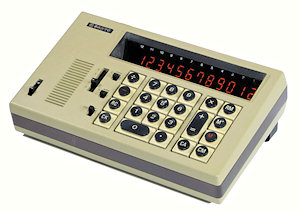
Contents |

|
| Sanyo ICC-1122 Desk Calculator, 1971. |
The Sanyo Electric Company commenced operations in 1947 when founder Toshio Iue acquired a disused Matsushita (later Panasonic) factory through family connections and began making bicycle lamps and generators. The company expanded into domestic appliances and consumer electronics, including radios, televisions, washing machines, and refrigerators. The "ICC-xxx" range of "Integrated Circuit Calculators" was introduced in about 1968. Sanyo's domestic products declined during the 2000s, and in 2012 the company was absorbed back into Panasonic.
In addition to its domestic product lines, Sanyo has been a major contributor to the development of rechargeable battery technology. Their "Cadnica" nickel-cadmium batteries were mass-produced from 1964, nickel metal hydride batteries from 1990, and lithium-ion batteries from 1994. Many of Sanyo's early electronic calculators were fitted with internal "Cadnica" battery packs. The company currently makes lithium-ion battery packs for automotive applications, and is a major producer of solar cells.
Sanyo's range of desktop and portable calculators were generally quite well regarded. The machines on this page have been chosen to show the rapid progress that was made in circuitry, components, and packaging during the early 1970s. Click on the pictures below for larger illustrations, or follow the links for further details.
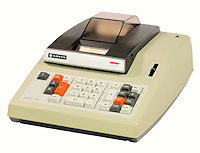 Sanyo ICC-1416P Printing Calculator, S/N 81427784
Sanyo ICC-1416P Printing Calculator, S/N 81427784
Functions: ASMD, auto constant, memory
Technology: MOS-LSI (6 chips)
Display: 18-column impact printer
Dimensions: 245W x 340D x 135H
Weight: 4.7kg
Manufactured: Sanyo Electric Co, Osaka, Japan, 1971-73.
The ICC-1416P is an electronic printing calculator which emulates the functions of the traditional mechanical adding machines. Addition and subtraction use the traditional Total and Sub-Total keys, while multiplication and division operate algebraically. The machine has a single memory register which can be accessed directly, or set to automatically accumulate products and quotients. A slider switch selects 0 to 9 fixed decimal places.
A modular impact printer, Model EP-102, from Shinshu Seiki Co. (later to become Epson Corporation) records all entries and results with up to 15 numeric digits and two columns of symbols. The paper roll is enclosed within the body of the machine.
The internal circuitry is built on a double-sided board which measures 220 x 180mm overall. The board carries six MOS-LSI chips, numbered LM8011 to 8016, in 36-pin ceramic flat-packs. The chips were made by Sanyo under licence from General Instruments in the USA, and are stamped with both the "Sanyo" name and the General Instruments logo. Chips 8011 to 8014 have date codes in 1970-71, while the last two are dated 7235 and 7303. There are four smaller support chips, 20 transistors to drive the printer solenoids, and a host of discrete components. The clock frequency is only 67kHz, so calculations are relatively slow.
The power supply, including IEC input socket, line filter,
transformer, and voltage selector, is built as a self-contained module
on an aluminium chassis at the rear of the machine. The supply produces
regulated -15 and -27V outputs, with plug-and-socket connections to the
main circuit board. The keyboard uses glass reed switches operated by
magnets on the ends of the keystems.
ICC-1416P internal view
ICC-1416P circuit board
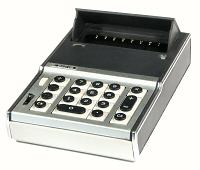 Sanyo Model ICC-82D
Sanyo Model ICC-82D
Functions: ASMD
Technology: MOS-LSI (4 chips), NiCad batteries
Display: 8 digits, 7-segment neon
Dimensions: 135W x 210D x 50H, weight 1.06kg
Manufactured: Sanyo Electric Co, Osaka, Japan, 1971
The ICC-82D was Sanyo's first portable calculator. Two versions were produced, both using an internal "Cadnica" battery pack and an external charger. The first version (from May 1970) used Nixie-style display tubes, while the version illustrated (from January 1971) uses Sanyo's own "Eightron" 7-segment (plus decimal point) gas discharge tubes, type SMI-01. Details of the Eightron tubes and numerals are included in the description of the ICC-1122 following. Both versions of the ICC-82D have a pop-up sun-shield to protect the display.
The calculator does the four basic functions (ASMD), with a selector switch for 0, 2, 3, 4, or 6 decimal places. It has a double-precision mode and a shift key (marked with a double arrow) to display 16-digit products. The keyboard uses glass reed switches operated by magnets on the ends of the keystems.
The double-sided circuit board measures 175x115mm, and carries four Sanyo chips made under licence from General Instruments. The Nixie version uses chips LM8001 to 8004, while the later version replaces LM8004 with LM8005 to drive the 7-segment Eightron tubes. The battery pack contains five Sanyo Sub-C NiCad cells of 1200mAh capacity.
The calculator was supplied in a high-class lined carrying case
with a metal handle, removable lid, and access for the charger
connection.
ICC-82D circuit board.
ICC-82D carrying case.
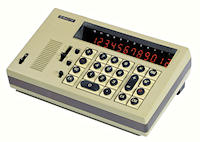 Sanyo Model ICC-1122, S/N 7103240
Sanyo Model ICC-1122, S/N 7103240
Functions: ASMD, constant, total, 1 memory
Technology: MOS-LSI (2 chips)
Display: 12 digits, fixed decimal, 7-segment neon tubes
Dimensions: 225W x 135D x 55H, weight 1.3kg
Manufactured: Sanyo Electric Co, Osaka, Japan, 1971
The ICC-1122 is a 12-digit mains-powered calculator in a portable
case that could easily be mistaken for one of Sanyo's transistor radios.
More...
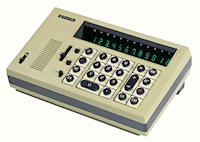 Sanyo Model ICC-1123, S/N 81513300
Sanyo Model ICC-1123, S/N 81513300
Functions: ASMD, constant, total, 1 memory
Technology: MOS-LSI (3 chips)
Display: 12 digits, vacuum fluorescent tubes
Dimensions: 225W x 135D x 55H, weight 1.3kg
Manufactured: Sanyo Electric Co, Osaka, Japan, 1973
The ICC-1123 is externally identical to the ICC-1122 above, but its
internal components and circuitry are totally different.
More...
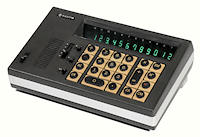 Sanyo Model ICC-1123, S/N 91518115
Sanyo Model ICC-1123, S/N 91518115
Functions: ASMD, constant, total, 1 memory
Technology: MOS-LSI (3 chips)
Display: 12 digits, vacuum fluorescent tubes
Dimensions: 225W x 135D x 55H, weight 1.3kg
Manufactured: Sanyo Electric Co, Osaka, Japan, 1973
The ICC-1123 was also available with a black case and bright
anodised trim.
More...
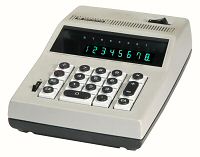 Sanyo Model ICC-805, S/N 86283205
Sanyo Model ICC-805, S/N 86283205
Functions: ASMD, constant
Technology: MOS-LSI (single chip)
Display: 8 digits, VFD tubes
Dimensions: 150W x 240D x 70H, weight 1.1kg
Manufactured: Sanyo Electric Co, Osaka, Japan, 1973
The ICC-805 from 1973 is a basic 8-digit mains-powered calculator in a more conventional desktop case. The keyboard layout is the same as the ICC-1122 and 1123 above, but without the Memory keys. The display uses the same DG10R1 fluorescent tubes as the ICC-1123, with all eight segments driven. The decimal point floats within the 8-digit range, but there is no provision for setting the number of decimal places displayed. The processor is a NEC μPDK271D, with 3 support chips and a host of discrete components. Power consumption is rated at 240V AC 5W.
In 1973 the "ICC" numbering was replaced with different prefixes for different classes of machines. "CX" was used for general-purpose pocket-sized machines, "CY" for small desktop machines, and "CZ" for scientific calculators.
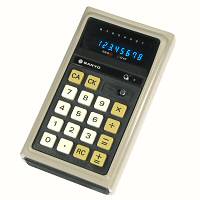 Sanyo Model CX-8001, S/N 87062720
Sanyo Model CX-8001, S/N 87062720
Functions: ASMD, constant
Technology: MOS-LSI (single chip)
Display: 8 digits, vacuum fluorescent tube
Dimensions: 85W x 145D x 35H, weight 300g.
Manufactured: Sanyo Electric Co, Japan, 1973
The Sanyo CX-8001 is a basic eight-digit portable calculator which
uses exactly the same NEC 271D processor and support chips as the
desktop ICC-805 above. The keyboard has the same 18 keys, but in a
more compact arrangement. The display uses an eight-digit double-ended
vacuum fluorescent tube instead of the eight individual tubes of the
earlier models. The seven-segment numerals only 5mm high. An unusual
feature is the use of a pair of (then very new) light-emitting diodes
for the negative and overflow indications. The battery-operated power
supply draws about 120 to 150mA (about 700-900mW) from four disposable
AA cells or an external 6V adaptor (Sanyo type CU-8001E).
CX-8001 circuit board (note LEDs in centre).
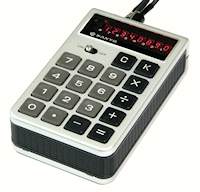 Sanyo Model CX-8002, S/N 82702457
Sanyo Model CX-8002, S/N 82702457
Functions: ASMD, constant
Technology: MOS-LSI (single chip), NiCad batteries
Display: 8 digits, red LED modules
Dimensions: 64W x 104D x 28H, weight 230g
Manufactured: Sanyo Electric Co, Osaka, Japan, 1973
The Sanyo CX-8002 is a very small (for 1973) pocket calculator with a red LED display and an internal NiCad battery pack. Red LEDs were first made in 1962, and were extremely expensive devices. The introduction of modular seven-segment LED displays in the early 1970s reduced the cost significantly, but the CX-8002 would still have been quite an expensive calculator.
The CX-8002 has only the four basic functions plus a Constant key. It was supplied with a soft case, carrying strap, and an external battery charger (Sanyo type CU-8002). The circuitry uses a single C500 processor chip from General Instruments, with a NEC μPD128C and discrete transistors to drive the tiny 7-segment LED modules. The processor chip has a date code of May 1973.
To achieve the very small external dimensions, the Sanyo designers
adopted a very peculiar method of construction. The
internal view shows the display modules and the keyboard spring
contacts on a full-size board at the top of the case, with the power
supply and LED drivers on a small board underneath. The boards are
connected by a short and rather inflexible ribbon. The processor
chip requires no board space at all, as it is mounted vertically
between the two boards with one row of pins plugged in to each. The
space under the keyboard is occupied by a battery pack containing
four of Sanyo's own "Cadnica" AA cells. The battery is rated at 4.8V,
500mAh, and the consumption is 1100mW. Running time is not mentioned
in the operator's manual, but (from caclulation) it could not have
been more than about two hours.
CX-8002 internal view.
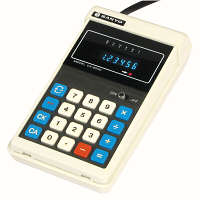 Sanyo "Mini", Model CX-6000, S/N 04648108
Sanyo "Mini", Model CX-6000, S/N 04648108
Functions: ASMD, auto constant
Technology: MOS-LSI (single chip)
Display: 6/12 digits, vacuum fluorescent tube
Dimensions: 90W x 155D x 40H, weight 320g.
Manufactured: Sanyo Electric Co, Japan, 1974
The Sanyo CX-6000 "Mini"is a portable battery-powered calculator with twelve-digit precision, although it only has a six-digit display. A blue double-arrow key switches between the first and second groups of six digits. A red LED at the lower right of the display lights whenever further digits are available. The calculator uses a D234C processor (branded Sanyo, but most probably made by NEC), with about 50 discrete components. The six-digit display uses a double-ended Futaba fluorescent tube. The processor drives the display tube directly, with no additional support chips needed.
The calculator has a hard plastic slide-on cover to protect the
keyboard and display, and a carrying strap at the rear. There is a
brief instruction sheet with examples inside the cover. The power
consumption has been reduced to about 400mW, from four disposable
AA batteries or an external 6V adaptor.
CX-6000 circuit board.
CX-6000 with cover.
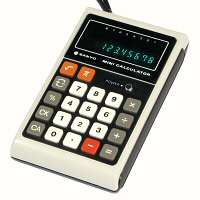 Sanyo "Mini", Model CX-8016, S/N 04602731
Sanyo "Mini", Model CX-8016, S/N 04602731
Functions: ASMD, constant, percent, square root, π
Technology: MOS-LSI (single chip)
Display: 8 digits, VFD tube
Dimensions: 87W x 146D x 32H, weight 275g
Manufactured: Sanyo Electric Co, Osaka, Japan, 1975
The CX-8016 "Mini" from 1975 is an 8-digit portable calculator which includes square root and percentage functions and a π key. The processor is a single μPD940C from NEC, with no additional support chips and only a few discrete components. The display uses a 9-digit fluorescent display tube, with the ninth digit used only for Minus and Error indication. The power consumption has been further reduced to only 250mW, from four AA cells or an external adaptor (Sanyo CU-05). The CX-8016 casing is slightly more "mini" than the CX-6000, and has an improved hard-plastic cover which can be clipped on underneath while the calculator is in use.
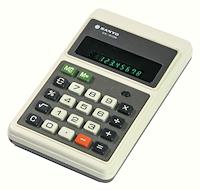 Sanyo Model CX-8136, S/N 09014025
Sanyo Model CX-8136, S/N 09014025
Functions: ASMD, percent, square root, 1 memory
Technology: MOS-LSI (single chip)
Display: 8 digits, VFD tube
Dimensions: 75W x 125D x 23H, weight 140g
Manufactured: Sanyo Electric Co, Osaka, Japan, 1976
The CX-8136 from 1976 is a compact pocket-size calculator with square root, percent, and memory functions. The processor is a μPD277C from NEC, with a 9-digit double-ended display tube from Futaba. Power consumption is rated at 300mW from two disposable AA batteries.
Although this CX-8136 was made in 1976, the NEC μPD277C processor
chip actually dates from the early 1970s. It was used in several other
early calculators, including the
Sharp EL-8102 from 1973.
CX-8136 internal view.
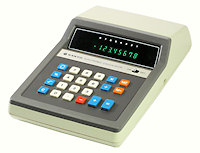 Sanyo Battery-powered Desk Calculator, Model CY-8150, S/N 09202597
Sanyo Battery-powered Desk Calculator, Model CY-8150, S/N 09202597
Functions: ASMD, percent, square root, 1 memory
Technology: MOS-LSI (single chip)
Display: 8 digits, vacuum fluorescent panel
Dimensions: 150W x 240D x 65H, weight 530g (with batteries 1kg).
Manufactured: Sanyo Electric Co, Japan, 1975
The Sanyo CY-8150 from 1975 is essentially the same 8-digit pocket calculator as the CX-8136 above, but re-packaged into a compact desktop case similar to that of the ICC-805. It uses the same NEC μPD277C processor as the CX-8136 and has the same square root, percentage, and memory functions. The keyboard has the same 22 keys but in a more spacious arrangement.
The internal view
reveals a "pocket-size" circuit board fitted with a larger display panel
and D-size instead of AA batteries. Power consumption with the larger
display is about 400mW. An external mains adaptor CU-05 was also available.
CY-8150 internal view..
CY-8150 circuit board..
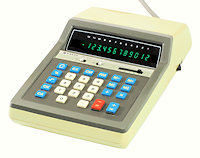 Sanyo Model CY-2131, S/N 04600524
Sanyo Model CY-2131, S/N 04600524
Functions: ASMD
Technology: MOS-LSI (single chip)
Display: 12 digits, vacuum fluorescent panel
Dimensions: 150W x 240D x 65H, weight 990g.
Manufactured: Sanyo Electric Co, Japan, 1977
The mains-powered CY-2131 from 1977 maintains the same compact form factor as
the CY-8150 above, but with a 12-digit display, a more elaborate keyboard, and
selectable roundoff, constant, and decimal functions. The processor is a
Mitsubishi M58623-23P with a Futaba 13-BT-02A fluorescent display panel. The
operation is quite conventional with no surprises.
CY-2131internal view.
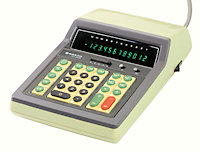 Sanyo Model CY2132, S/N 02302167
Sanyo Model CY2132, S/N 02302167
Functions: ASMD
Technology: MOS-LSI (single chip)
Display: 12 digits, vacuum fluorescent panel
Dimensions: 150W x 240D x 65H, weight 990g.
Manufactured: Sanyo Electric Co, Japan, 1977
The CY-2132 was an "update" to the 2131 to tidy up the internal wiring, simplify
assembly, and improve the rather poor feel of the previous elastomer-only keyboard.
The new keyboard uses conventional spring-loaded keys and an elastomeric "key-sheet"
of contact buttons, and has a much more positive action. The circuitry and operation
are unchanged.
CY-2132 internal view..
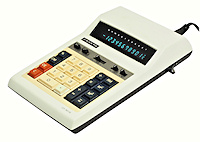 Sanyo Model CY-5012, S/N 13501284
Sanyo Model CY-5012, S/N 13501284
Functions: ASMD
Technology: MOS-LSI (single chip)
Display: 12 digits, vacuum fluorescent panel
Dimensions: 150W x 240D x 55/70H, weight 680g.
Manufactured: Sanyo Electric Co, Japan, 1980
The CY-5012 from 1980 has the same horizontal dimensions as the models above but is about 10mm thinner. A fold-out wire stand at the rear raises the display to a more convenient angle. The processor is a Hitachi HD38401A, which also appeared in several Canon calculators of the time. The Futaba 13-BT-18A display panel has both decimal points and commas, with the commas used as thousands separators. The single-sided circuit board has about 60 individual wire links.
The keyboard uses spring-loaded keys with individual elastomeric contact
buttons. Mains power is supplied via a detachable figure-8 cord and is rated
at 2 Watts. The On/Off switch is on the secondary side of the power transformer,
leaving the primary side permanently energised.
CY-5012 internal view..
CY-5012 keyboard
contact buttons..
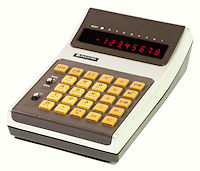 Sanyo Model CZ-8100, S/N 7061418S
Sanyo Model CZ-8100, S/N 7061418S
Functions: Portable, scientific
Technology: MOS-LSI (single chip), internal NiCad batteries
Display: 8 digits, red LED modules
Dimensions: 100W x 164D x 30-50H, weight 350g
Manufactured: Sanyo Electric Co, Osaka, Japan, 1974
The CZ-8100 from 1974 is a portable scientific calculator with an internal NiCad battery. It provides trig functions and their inverses in degrees or radians, powers, roots, and logarithms, and a single memory register. The 8-digit display has a floating decimal point, but does not use scientific notation.
The calculator uses a single-chip processor (Rockwell 15471PA) with three support chips. The display uses eight 7-segment LED modules. The battery pack contains four AA-size Cadnica cells, and is recharged via an external AC adapter type CU-02E. When running on battery the calculator draws 120-150mA (600-700mW, depending on the contents of the display), giving a run time of about 3 hours from the 450mAh NiCads. The nameplate power rating is 9V 2W.
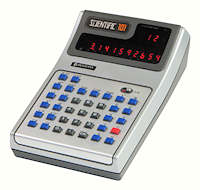 Sanyo Model CZ-2171, S/N 70040205
Sanyo Model CZ-2171, S/N 70040205
Functions: Portable, scientific
Technology: MOS-LSI (two chips), internal NiCad batteries
Display: 10+2 digits, red LED modules
Dimensions: 100W x 164D x 30-50H, weight 380g
Manufactured: Sanyo Electric Co, Osaka, Japan, 1975
The CZ-2171 from 1975 uses the same case as the CZ-8001 above, but with a different colour scheme and keyboard layout. This machine uses scientific notation with two levels of parentheses to support more complex calculations. It provides trig functions and their inverses in degrees or radians, powers, roots, and logarithms, and a single memory register. The scientific functions are generally accurate to better than 8 figures.
The processor uses two chips (MCS-2525 and 2526) made in America
by MOS Technologies (who also made the 6502 microprocessor used in the
Commodore 64 computer). The display board carries 11 7-segment LED
modules (10 numerals plus sign), with a separate 2-digits-plus-sign
display for the exponent. The battery pack contains five AA-size
Cadnica cells and is rated at 6V 450mAh. The battery is recharged
via an external AC adapter type CU-16A.
CZ-2171 internal view.
CZ-2171 processor and display boards.
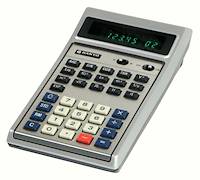 Sanyo Model CZ-8127, S/N 04500938
Sanyo Model CZ-8127, S/N 04500938
Functions: Portable, scientific
Technology: MOS-LSI (one chip)
Display: 8 digits, VFD module
Dimensions: 86W x 157D x 36H, weight 240g
Manufactured: Sanyo Electric Co, Osaka, Japan, 1976
The CZ-8127 from 1976 provides similar functions to the CZ-2171 above, but with lower cost, speed, and accuracy. The processor is a Rockwell A6500CA, which was also used in other low-cost scientific calculators of the time (eg, the Qualitron 1450).
The display uses a flat-panel VFD module with 9 digits. In normal mode it displays 8 digits plus sign, but in scientific mode the display is limited to 5 digits plus 2 exponents (leaving space for two sign digits). The scientific functions are normally accurate to six figures, but only five can be displayed in scientific notation. Multiplications and divisions are completed in about 200mS, but trig and log functions can take up to 5 seconds.
The calculator has a removable battery drawer under the display.
The standard drawer holds two disposable AA batteries, with provision
for an AC adapter CU-25. The optional RU-01 drawer is a sealed unit
containing two AA NiCad batteries, which are recharged from the same
AC adaptor. Power consumption is rated at 500mW.
CZ-8127 circuit board and display.
CZ-8127 rear view with battery drawer.